冀教版七年级下册Unit 2 It's Show Time! Lesson 12 A Blog about the Silk Road课件(共23张PPT)
文档属性
| 名称 | 冀教版七年级下册Unit 2 It's Show Time! Lesson 12 A Blog about the Silk Road课件(共23张PPT) |  | |
| 格式 | pptx | ||
| 文件大小 | 945.7KB | ||
| 资源类型 | 教案 | ||
| 版本资源 | 冀教版 | ||
| 科目 | 英语 | ||
| 更新时间 | 2024-05-02 18:57:16 | ||
图片预览

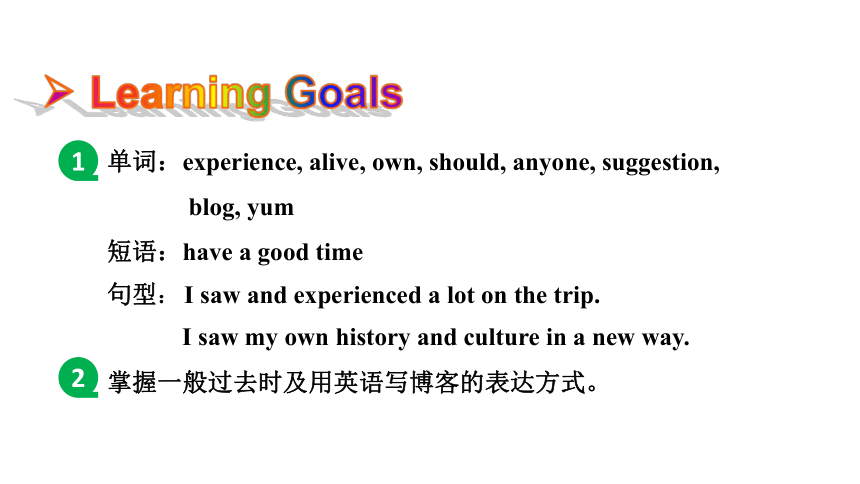
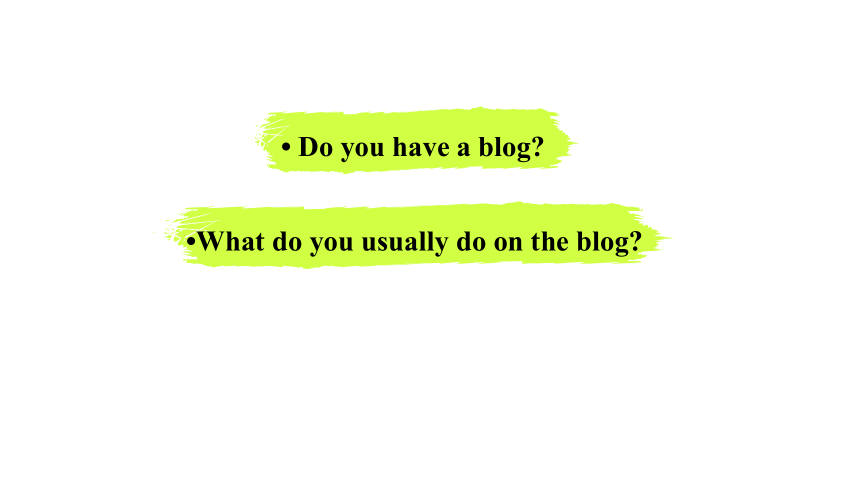
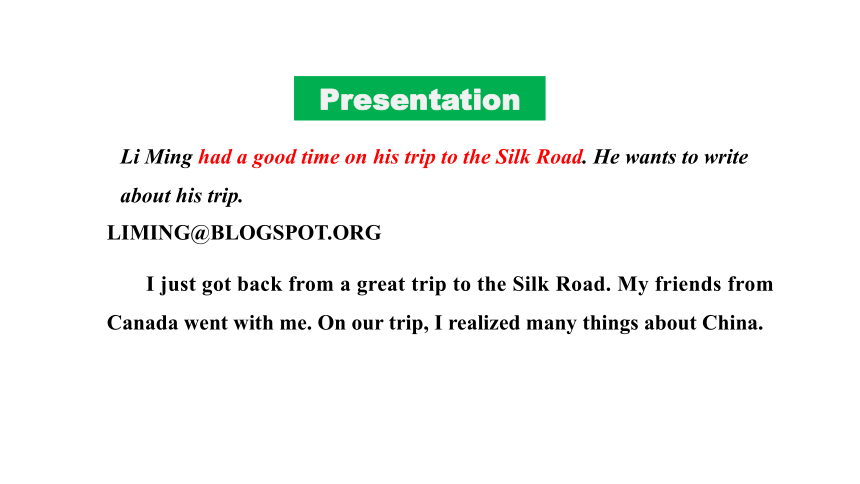

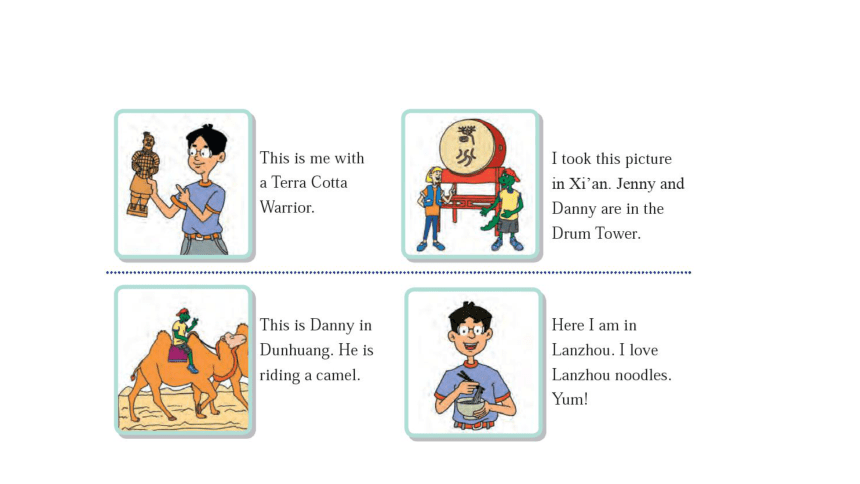
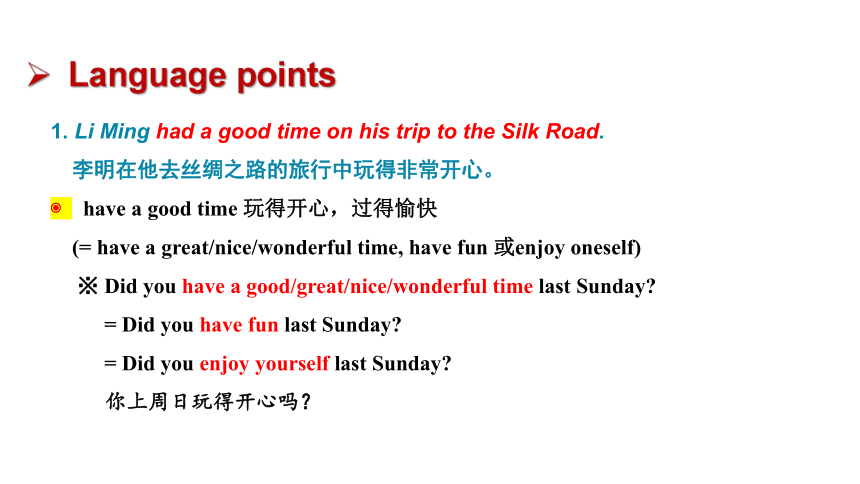
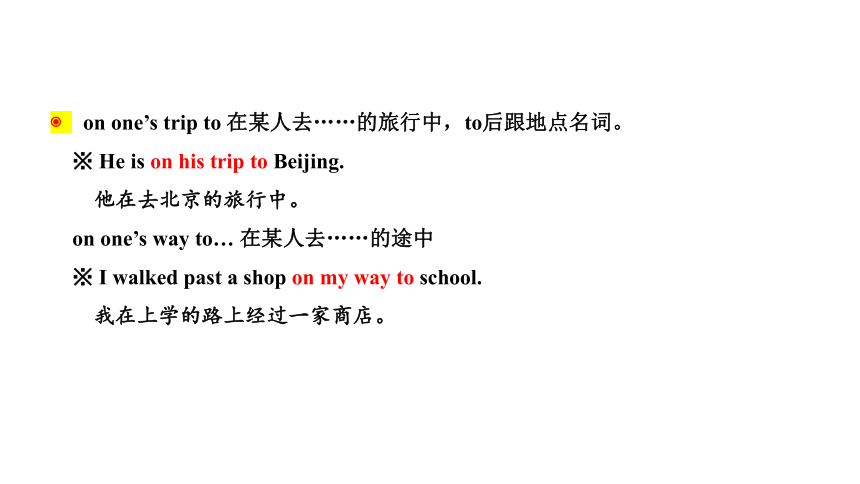
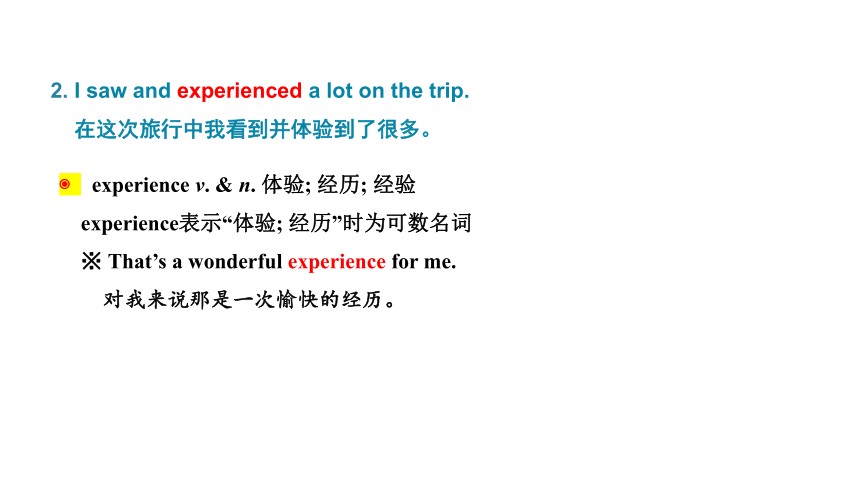
文档简介
(共23张PPT)
Lesson 12: A Blog about the Silk Road
Unit 2 It’s Show Time!
单词:experience, alive, own, should, anyone, suggestion,
blog, yum
短语:have a good time
句型: I saw and experienced a lot on the trip.
I saw my own history and culture in a new way.
掌握一般过去时及用英语写博客的表达方式。
Learning Goals
1
2
Do you have a blog
What do you usually do on the blog
Presentation
I just got back from a great trip to the Silk Road. My friends from Canada went with me. On our trip, I realized many things about China.
Li Ming had a good time on his trip to the Silk Road. He wants to write about his trip.
LIMING@BLOGSPOT.ORG
Our country has a very long history and a rich culture.
I saw and experienced a lot on the trip. We went to see the Terra Cotta Warriors and the ancient city of Xi’an. The history of China is so alive in these places. I learned so much!
This trip opened my eyes. I saw my own history and culture in a new way. I hope to travel more around my country someday.
Where should I go next Does anyone have any suggestions
Here are some photos from my trip. Enjoy!
Language points
1. Li Ming had a good time on his trip to the Silk Road.
李明在他去丝绸之路的旅行中玩得非常开心。
have a good time 玩得开心,过得愉快
(= have a great/nice/wonderful time, have fun 或enjoy oneself)
※ Did you have a good/great/nice/wonderful time last Sunday
= Did you have fun last Sunday
= Did you enjoy yourself last Sunday
你上周日玩得开心吗?
on one’s trip to 在某人去……的旅行中,to后跟地点名词。
※ He is on his trip to Beijing.
他在去北京的旅行中。
on one’s way to… 在某人去……的途中
※ I walked past a shop on my way to school.
我在上学的路上经过一家商店。
2. I saw and experienced a lot on the trip.
在这次旅行中我看到并体验到了很多。
experience v. & n. 体验; 经历; 经验
experience表示“体验; 经历”时为可数名词
※ That’s a wonderful experience for me.
对我来说那是一次愉快的经历。
3. The history of China is so alive in these places.
在这些地方,中国的历史是如此有活力。
辨析alive、living、lovely和live
alive 意为“活着的”,侧重生与死之间的界限 常作表语、宾语补足语或后置定语 多用于指人,也可指物
living 意为“活着的”,强调说明“健在” 常作表语或定语 多用于指物,也可指人
lively 意为“生气勃勃的;(色彩)鲜艳的” 常作定语、表语或宾语补足语 既可指人,又可指物
live 读作/laiv/时,意为“活的” 一般作定语 一般只修饰物,不修饰人
※ The old man is still alive.
那位老人还活着。
※ He is the best living pianist.
他是健在的最好的钢琴家。
※ Jenny is a lively girl.
詹妮是个活泼的女孩。
※ This is a live fish.
这是一条活鱼。
4. I saw my own history and culture in a new way.
我用一种新的方式来看待自己的历史和文化。
own
adv. 自己的
※ I saw it with my own eyes. 我亲眼看到了它。
v. 拥有(= have)
※ He owns a big house in the countryside. 他在乡下有一座大房子。
in a...way 用……方式/方法
※ My brother always tries doing things in a new way.
我哥哥总是尝试用一种新方式做事情。
※ Can you do it in a different way 你能用一种不同的方式做这件事吗?
5. Where should I go next 下一次我应该去哪里呢?
should 情态动词, 意为“应该”, 情态动词不能单独在句子中作谓语, 必须接动词
原形一起构成谓语部分。
否定式为should not, 可缩写为shouldn’t
should没有人称和数的变化, 即用在所有人称后面都用原形, 当含有should的陈
述句变为疑问句时, 要将should放在主语的前面。
※ You should follow his suggestion. 你应该接受他的建议。
→ Should I follow his suggestion 我应该接受他的建议吗?
6. Does anyone have any suggestions
有人能给出一些建议吗?
anyone 任何人,无论谁(= anybody)
常用于否定句、疑问句或条件状语从句中;若强调“任何人”,可用于肯定
句中。作主语时谓语动词用单数。
※ Does anyone else want to come
还有人想来吗?
※ Anyone can see that it is wrong.
任何人都能看出那是错误的。
辨析anyone和any one
anyone 仅指人, 后面不能接介词of
Has anyone called
有人打电话了吗?
any one 指人或物, 后面可接介词of
You may get any one of the books.
你可以得到这些书中的任何一本。
辨析 someone & somebody、anyone & anybody、no one & nobody
someone & somebody 某人 常用于肯定句中
anyone & anybody 任何人 常用于疑问句、否定句中或条件状语从句中; 强调“任何人”,可用于肯定句中
everyone & everybody 所有人 常用于肯定句、疑问句中
no one & nobody 没有人 常用于肯定句中
suggestion 建议
常见搭配
make a suggestion 提出建议
give suggestions to 给……建议
give suggestions on 给出关于……的建议
※ Please give me some suggestions on learning English.
请给我一些学习英语的建议。
1. Which pictures does LiMing NOT mentioned Listen to the
passage and tick.
Let’s do it!
√
√
2. Read the lesson and fill in the blanks.
Li Ming had a good time on his trip to the Silk Road. He saw and ______________ many great things. On the trip, he learned China has a ________ history and a ________ culture. The history of China is ________ in the ancient city of Xi’an. He ________ to travel more around his country someday.
experienced
long
rich
alive
hopes
3. Wang Mei is searching for more information about the Silk Road. Work
in groups. Help her answer the questions below.
1.When did people begin to travel along the Silk Road
_______________________________________________________
2.What other cities or districts does the Silk Road go through
_______________________________________________________
3. How did it get the name the “Silk Road”
_______________________________________________________
People began to travel along the Silk Road during Han Dynasty.
Xi’an and Lanzhou.
The Silk Road got its name from the Chinese silk trade along it.
4. Write an e-mail to a friend about a trip you went on. Show
him or her some pictures from your trip.
Task tips: Where / When did you go Who did you go with What did you see and experience Did you eat any traditional or special foods
I went to Wuhan with my family last summer. I saw the East lake, the Yellow Crane Tower and the Changjiang River. I ate lots local foods and my favourite one was the Hot and Dry Noodles.
Practice
用所给单词的适当形式填空
1. This ______ (be) me with a funny dog.
2. No one has any new ____________ (suggestion)
about the New Year's party of my class.
3. I show some ______ (photo) to my classmates.
4. You should ______ (see) your grandparents once a week.
5. Look! Danny __________ (ride) a camel in the picture.
is
suggestions
photos
see
is riding
Homework
1. Remember the new words and expressions
learnt in this lesson.
2. Write an e-mail to a friend about one of your
trips, including some photos from your trip.
3. Preview Unit Review.
Lesson 12: A Blog about the Silk Road
Unit 2 It’s Show Time!
单词:experience, alive, own, should, anyone, suggestion,
blog, yum
短语:have a good time
句型: I saw and experienced a lot on the trip.
I saw my own history and culture in a new way.
掌握一般过去时及用英语写博客的表达方式。
Learning Goals
1
2
Do you have a blog
What do you usually do on the blog
Presentation
I just got back from a great trip to the Silk Road. My friends from Canada went with me. On our trip, I realized many things about China.
Li Ming had a good time on his trip to the Silk Road. He wants to write about his trip.
LIMING@BLOGSPOT.ORG
Our country has a very long history and a rich culture.
I saw and experienced a lot on the trip. We went to see the Terra Cotta Warriors and the ancient city of Xi’an. The history of China is so alive in these places. I learned so much!
This trip opened my eyes. I saw my own history and culture in a new way. I hope to travel more around my country someday.
Where should I go next Does anyone have any suggestions
Here are some photos from my trip. Enjoy!
Language points
1. Li Ming had a good time on his trip to the Silk Road.
李明在他去丝绸之路的旅行中玩得非常开心。
have a good time 玩得开心,过得愉快
(= have a great/nice/wonderful time, have fun 或enjoy oneself)
※ Did you have a good/great/nice/wonderful time last Sunday
= Did you have fun last Sunday
= Did you enjoy yourself last Sunday
你上周日玩得开心吗?
on one’s trip to 在某人去……的旅行中,to后跟地点名词。
※ He is on his trip to Beijing.
他在去北京的旅行中。
on one’s way to… 在某人去……的途中
※ I walked past a shop on my way to school.
我在上学的路上经过一家商店。
2. I saw and experienced a lot on the trip.
在这次旅行中我看到并体验到了很多。
experience v. & n. 体验; 经历; 经验
experience表示“体验; 经历”时为可数名词
※ That’s a wonderful experience for me.
对我来说那是一次愉快的经历。
3. The history of China is so alive in these places.
在这些地方,中国的历史是如此有活力。
辨析alive、living、lovely和live
alive 意为“活着的”,侧重生与死之间的界限 常作表语、宾语补足语或后置定语 多用于指人,也可指物
living 意为“活着的”,强调说明“健在” 常作表语或定语 多用于指物,也可指人
lively 意为“生气勃勃的;(色彩)鲜艳的” 常作定语、表语或宾语补足语 既可指人,又可指物
live 读作/laiv/时,意为“活的” 一般作定语 一般只修饰物,不修饰人
※ The old man is still alive.
那位老人还活着。
※ He is the best living pianist.
他是健在的最好的钢琴家。
※ Jenny is a lively girl.
詹妮是个活泼的女孩。
※ This is a live fish.
这是一条活鱼。
4. I saw my own history and culture in a new way.
我用一种新的方式来看待自己的历史和文化。
own
adv. 自己的
※ I saw it with my own eyes. 我亲眼看到了它。
v. 拥有(= have)
※ He owns a big house in the countryside. 他在乡下有一座大房子。
in a...way 用……方式/方法
※ My brother always tries doing things in a new way.
我哥哥总是尝试用一种新方式做事情。
※ Can you do it in a different way 你能用一种不同的方式做这件事吗?
5. Where should I go next 下一次我应该去哪里呢?
should 情态动词, 意为“应该”, 情态动词不能单独在句子中作谓语, 必须接动词
原形一起构成谓语部分。
否定式为should not, 可缩写为shouldn’t
should没有人称和数的变化, 即用在所有人称后面都用原形, 当含有should的陈
述句变为疑问句时, 要将should放在主语的前面。
※ You should follow his suggestion. 你应该接受他的建议。
→ Should I follow his suggestion 我应该接受他的建议吗?
6. Does anyone have any suggestions
有人能给出一些建议吗?
anyone 任何人,无论谁(= anybody)
常用于否定句、疑问句或条件状语从句中;若强调“任何人”,可用于肯定
句中。作主语时谓语动词用单数。
※ Does anyone else want to come
还有人想来吗?
※ Anyone can see that it is wrong.
任何人都能看出那是错误的。
辨析anyone和any one
anyone 仅指人, 后面不能接介词of
Has anyone called
有人打电话了吗?
any one 指人或物, 后面可接介词of
You may get any one of the books.
你可以得到这些书中的任何一本。
辨析 someone & somebody、anyone & anybody、no one & nobody
someone & somebody 某人 常用于肯定句中
anyone & anybody 任何人 常用于疑问句、否定句中或条件状语从句中; 强调“任何人”,可用于肯定句中
everyone & everybody 所有人 常用于肯定句、疑问句中
no one & nobody 没有人 常用于肯定句中
suggestion 建议
常见搭配
make a suggestion 提出建议
give suggestions to 给……建议
give suggestions on 给出关于……的建议
※ Please give me some suggestions on learning English.
请给我一些学习英语的建议。
1. Which pictures does LiMing NOT mentioned Listen to the
passage and tick.
Let’s do it!
√
√
2. Read the lesson and fill in the blanks.
Li Ming had a good time on his trip to the Silk Road. He saw and ______________ many great things. On the trip, he learned China has a ________ history and a ________ culture. The history of China is ________ in the ancient city of Xi’an. He ________ to travel more around his country someday.
experienced
long
rich
alive
hopes
3. Wang Mei is searching for more information about the Silk Road. Work
in groups. Help her answer the questions below.
1.When did people begin to travel along the Silk Road
_______________________________________________________
2.What other cities or districts does the Silk Road go through
_______________________________________________________
3. How did it get the name the “Silk Road”
_______________________________________________________
People began to travel along the Silk Road during Han Dynasty.
Xi’an and Lanzhou.
The Silk Road got its name from the Chinese silk trade along it.
4. Write an e-mail to a friend about a trip you went on. Show
him or her some pictures from your trip.
Task tips: Where / When did you go Who did you go with What did you see and experience Did you eat any traditional or special foods
I went to Wuhan with my family last summer. I saw the East lake, the Yellow Crane Tower and the Changjiang River. I ate lots local foods and my favourite one was the Hot and Dry Noodles.
Practice
用所给单词的适当形式填空
1. This ______ (be) me with a funny dog.
2. No one has any new ____________ (suggestion)
about the New Year's party of my class.
3. I show some ______ (photo) to my classmates.
4. You should ______ (see) your grandparents once a week.
5. Look! Danny __________ (ride) a camel in the picture.
is
suggestions
photos
see
is riding
Homework
1. Remember the new words and expressions
learnt in this lesson.
2. Write an e-mail to a friend about one of your
trips, including some photos from your trip.
3. Preview Unit Review.
同课章节目录
- Unit 1 A Trip to the Silk Road
- Lesson 1 A Trip to China
- Lesson 2 Meet You in Beijing
- Lesson 3 A Visit to Xi'an
- Lesson 4 A Visit to Lanzhou
- Lesson 5 Another Stop along the Silk Road
- Lesson 6 Jenny's Diary
- Unit 2 It's Show Time!
- Lesson 7 What's Your Project about?
- Lesson 8 Marco Polo and the Silk Road
- Lesson 9 Danny's School Project
- Lesson 10 Music and Dance
- Lesson 11 Food in China
- Lesson 12 A Blog about the Silk Road
- Unit 3 School Life
- Lesson 13 How Is School Going?
- Lesson 14 Jenny's School Life
- Lesson 15 Making a Difference
- Lesson 16 We Are with You!
- Lesson 17 School Science Fai
- Lesson 18 Teaching in China
- Unit 4 After-School Activities
- Lesson 19 A Dinner Date
- Lesson 20 Join Our Club!
- Lesson 21 What Is Your Club Type?
- Lesson 22 Big Plans for the Weekend
- Lesson 23 A Weekend with Grandma
- Lesson 24 How was Your Weekend?
- Unit 5 I Love Learning English!
- Lesson 25 A Phone Friend
- Lesson 26 Online Phone Calls
- Lesson 27 Amazing English
- Lesson 28 How Do I Learn English?
- Lesson 29 A Door to the World
- Lesson 30 Writing an E-mail in English
- Unit 6 Seasons
- Lesson 31 What Strange Weather!
- Lesson 32 I Can't Wait for Winter!
- Lesson 33 Kim's Favourite Season
- Lesson 34 Steven's Report
- Lesson 35 Surfing in Sydney
- Lesson 36 Spring in China
- Unit 7 Sports and Good Health
- Lesson 37 You Are What You Eat!
- Lesson 38 Stay Healthy!
- Lesson 39 Danny's Report
- Lesson 40 Move Your Body
- Lesson 41 Were People Healthy Then?
- Lesson 42 Know Yourself
- Unit 8 Summer Holiday Is Coming!
- Lesson 43 Have a Good Summer!
- Lesson 44 Volunteering in Summe
- Lesson 45 Baseball Season
- Lesson 46 Get Ready for Summer Holiday!
- Lesson 47 Summer Plans
- Lesson 48 Li Ming's Summer Holiday
